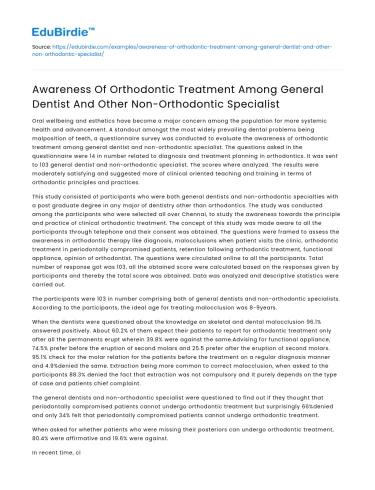Oral wellbeing and esthetics have become a major concern among the population for more systemic health and advancement. A standout amongst the most widely prevailing dental problems being malposition of teeth, a questionnaire survey was conducted to evaluate the awareness of orthodontic treatment among general dentist and non-orthodontic specialist. The questions asked in the questionnaire were 14 in number related to diagnosis and treatment planning in orthodontics. It was sent to 103 general dentist and non-orthodontic specialist. The scores where analyzed. The results were moderately satisfying and suggested more of clinical oriented teaching and training in terms of orthodontic principles and practices.
This study consisted of participants who were both general dentists and non-orthodontic specialties with a post graduate degree in any major of dentistry other than orthodontics. The study was conducted among the participants who were selected all over Chennai, to study the awareness towards the principle and practice of clinical orthodontic treatment. The concept of this study was made aware to all the participants through telephone and their consent was obtained. The questions were framed to assess the awareness in orthodontic therapy like diagnosis, malocclusions when patient visits the clinic, orthodontic treatment in periodontally compromised patients, retention following orthodontic treatment, functional appliance, opinion of orthodontist. The questions were circulated online to all the participants. Total number of response got was 103, all the obtained score were calculated based on the responses given by participants and thereby the total score was obtained. Data was analyzed and descriptive statistics were carried out.
Save your time!
We can take care of your essay
- Proper editing and formatting
- Free revision, title page, and bibliography
- Flexible prices and money-back guarantee
The participants were 103 in number comprising both of general dentists and non-orthodontic specialists. According to the participants, the ideal age for treating malocclusion was 8-9years.
When the dentists were questioned about the knowledge on skeletal and dental malocclusion 96.1% answered positively. About 60.2% of them expect their patients to report for orthodontic treatment only after all the permanents erupt wherein 39.8% were against the same.Advising for functional appliance, 74.5% prefer before the eruption of second molars and 25.5 prefer after the eruption of second molars. 95.1% check for the molar relation for the patients before the treatment on a regular diagnosis manner and 4.9%denied the same. Extraction being more common to correct malocclusion, when asked to the participants 88.3% denied the fact that extraction was not compulsory and it purely depends on the type of case and patients chief complaint.
The general dentists and non-orthodontic specialist were questioned to find out if they thought that periodontally compromised patients cannot undergo orthodontic treatment but surprisingly 66%denied and only 34% felt that periodontally compromised patients cannot undergo orthodontic treatment.
When asked for whether patients who were missing their posteriors can undergo orthodontic treatment, 80.4% were affirmative and 19.6% were against.
In recent time, clear aligners have taken over and when asked for the awareness of clear aligners, 88.2% were aware and 11.8% was unaware.
92.2% believe that orthodontic treatment has influence on TMJ and 83..5% thinks that orthodontic treatment can solve previously present TMJ problems.
When asked about retention following fixed orthodontic treatment 99% were positive and preference of using the retainers were widely varied in duration from 3mnths to lifelong.
Finally, 96.1% general dentist and non-orthodontic specialist prefer a specialist (orthodontist) to treat the patients who have their chief complaint of malocclusion.
Malocclusion being the second most common problem following dental caries in young adults n kids, and also esthetics being of major concern amelioration of malocclusion is important. The basic component behind orthodontic treatment being diagnosis and treatment planning this questionnaire survey was conducted among general dentists and non-orthodontic specialists to assess the awareness and knowledge in the branch of orthodontics. The results at the end of the questionnaire survey was moderately satisfied.






 Stuck on your essay?
Stuck on your essay?

